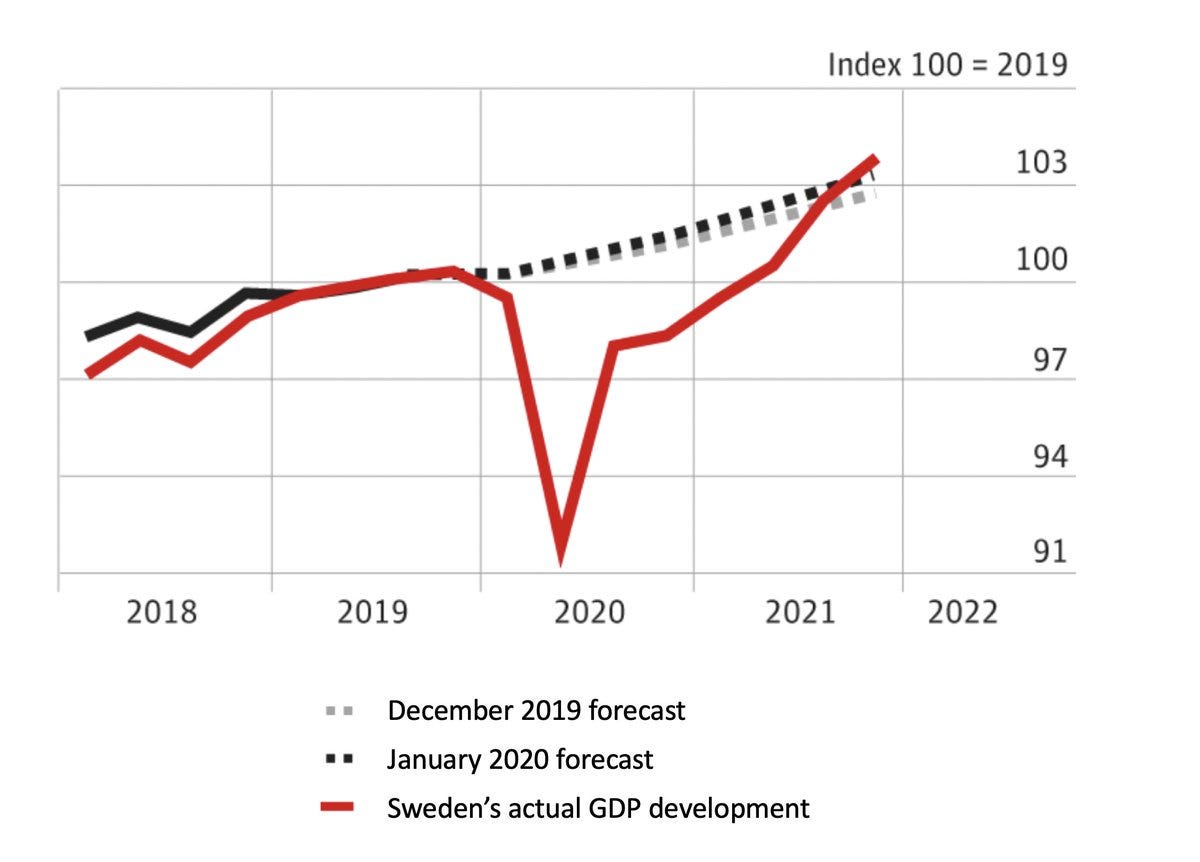There’s a recent paper and X-thread by Johan Norberg of the Cato Instutute that evaluates Sweden’s polices during the pandemic, and argues that these were superior on multiple grounds to the more restrictive approaches taken by other countries. In particular, argues Johan, Sweden performed as well or better than comparable countries with respect to all relevant metrics—economic growth, education outcomes, and excess deaths—all while avoiding lockdown and relying on voluntary compliance with public health guidelines.
While the debate is welcome, I think that some of the claims in the paper regarding Sweden’s relative economic performance are a bit misleading.
Johan presents the following striking figure to argue that unlike the US and the Eurozone, the Swedish economy was larger at the end of 2021 than had been forecast prior to the pandemic:
The figure compares actual performance (the red line) to forecasts made in December 2019 and January 2020, and shows that Sweden’s recovery from the trough was strong enough that it had already exceeded prior expectations by the end of 2021.
But was Sweden’s economic performance superior to that of its Scandinavian neighbors? I asked Johan if he had looked at this. He had not, but suggested that it would be a good idea to do so.
While I don’t have data on predictions prior to the pandemic, quarterly data on economic growth is available for several countries from the Federal Reserve. The following figure looks at economic performance (adjusted for inflation) in each of the Scandinavian countries, relative to the first quarter of 2019:
Economic growth in Sweden does not appear to have differed appreciably from that in Norway and Denmark over this period (Finland’s growth has been weaker). If anything, the trough was deeper in Sweden during the second quarter of 2020. The timing and strength of the subsequent recovery was comparable in Sweden, Norway, and Denmark.
The figure is not decisive, of course. Despite some similarities of climate and culture, the countries have very different institutions. Norway is in the Eurozone but not in the European Union, while Sweden is in the EU but uses its own currency. The countries have different levels of export dependence, and thus different vulnerabilities to global contractions. One would therefore like to compare results with predictions prior to the pandemic to get a more complete picture. But I think it’s safe to say that Sweden’s economy did not significantly outperform those of its neighbors during and immediately following the pandemic.
What about excess mortality? During the first year of the pandemic, excess deaths in Sweden were substantially higher than those previously projected, while the other Scandinavian countries experienced much less loss of life. But what appears to have happened is that excess deaths in other countries were delayed rather than avoided entirely, so that cumulative excess deaths have essentially converged:
That is, Sweden’s policies appear to have affected the timing rather than the eventual magnitude of excess mortality.
Based on this data, neither the economic benefits not the cumulative public health costs of Sweden’s singular response to the pandemic were appreciably different from those of Norway or Denmark. This is a bit of a puzzle, since the policy trajectories certainly were different.
There was a great deal of uncertainly about the wise course of action during the pandemic, and it’s well worth looking back at the consequences of different policy choices across countries (and across jurisdictions within countries). This paper is accordingly a welcome contribution to the debate. But on at least two counts—economic growth and excess mortality—the data supports neither clear vindication nor serious indictment of Sweden’s pandemic response.





I think excess deaths are much more meaningfully compared if grouped by age. The life-years lost are considerably different depending on whether young or old people are dying. That distinction is made in Canadian data by this paper: https://www.jccf.ca/wp-content/uploads/2023/08/The-rise-of-excess-and-unexplained-deaths-in-Canada_Justice-Centre.pdf